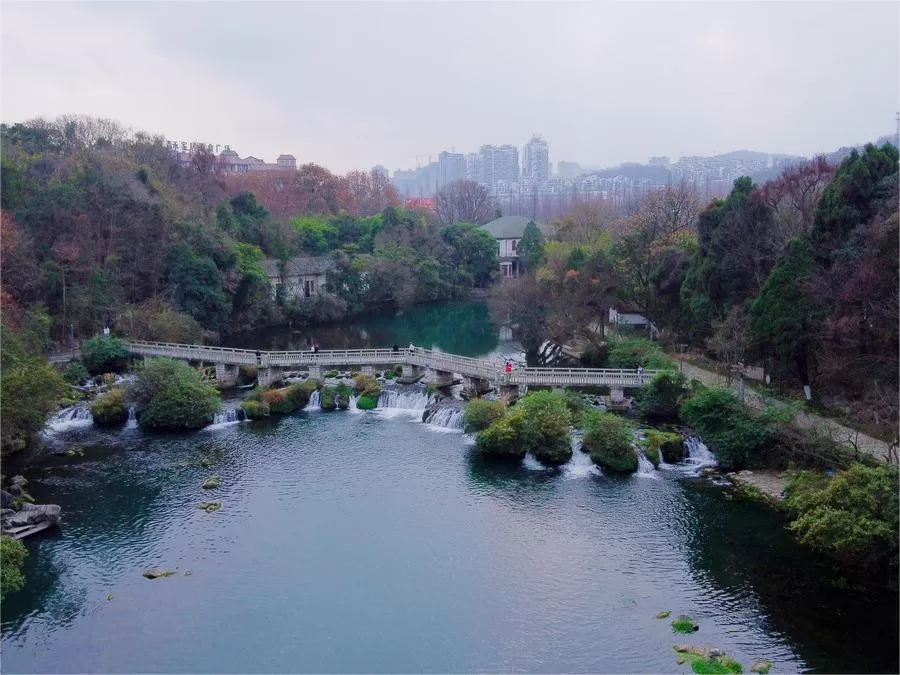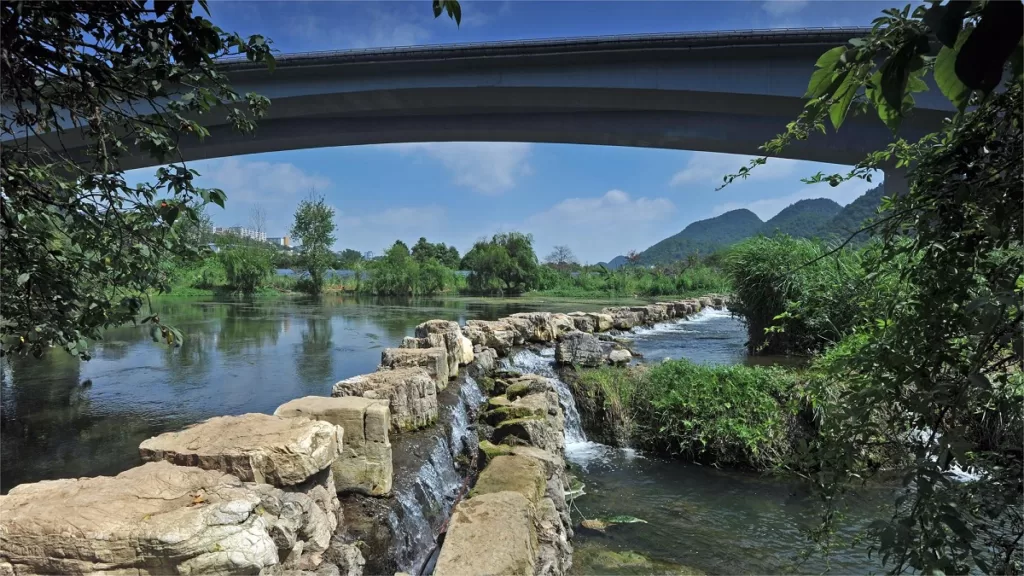Huaxi Park (花溪公园), also known as Flower Creek Park, is nestled in the southern outskirts of Guiyang, the capital city of Guizhou Province, China. Spanning an expansive 800 acres, its origins can be traced back to 1787 when it was initially developed by Zhou Kui, a scholar, and his son. However, it wasn’t until 1937 that the area began its transformation into a public park. In 1939, with the approval of the Guizhou Provincial Government, it officially became a scenic area and was largely completed by 1940, initially named “Zhongzheng Park.” Following the establishment of the People’s Republic of China in 1949, it was officially renamed Huaxi Park.
Huaxi Park seamlessly integrates picturesque landscapes, rural scenery, and local customs. During spring, the park is adorned with various blossoming flowers, providing a vibrant and colorful spectacle. In the summer, it serves as an ideal retreat to escape the heat. Autumn unveils a fairy-tale-like scenery as visitors stroll along the golden pathways blanketed by tung tree leaves. One of the park’s highlights is the meandering emerald waters, adorned with charming small bridges, most notably the intriguing Bai Bu Bridge with its winding stone steps submerged in the water.
Visitors to Huaxi Park can leisurely wander through its grounds, take a boat ride on the lake, or ascend small hills for panoramic views. The park also offers bicycle rental services, although the numerous small bridges may pose some inconvenience for cyclists who need to lift and carry their bikes. Huaxi Park, with its diverse natural beauty and cultural charm, provides a tranquil and enchanting escape for those seeking a respite from the hustle and bustle of city life.
Table of Contents
- Basic Information
- Location and Transportation
- Highlights of Huaxi Park
- Vlog about Huaxi Park
- Other Attractions in Huaxi District
Basic Information
| Estimated Length of Tour | 2 – 3 hours |
| Ticket Price | 6 RMB |
| Opening Hours | 8.30 – 18.00 (1st April – 31st October) 9.00 – 17.30 (1st November – 31st March) |
| Telephone Number | 0086-0851-83623593 |
Location and Transportation
Huaxi Park is nestled in the southern outskirts of Guiyang, Guizhou Province, specifically within the Huaxi District, approximately 17 kilometers away from the heart of Guiyang city. Its precise address is No. 3108, South Huaxi Avenue.
To get there, tourists can take bus 203, 207, 223, 404, 807, 808, Huaxi 1, Huaxi 2, Huaxi 6, or Huaxi 23, and get off at Huaxi Park Stop (花溪公园站).
Highlights of Huaxi Park
Scenic Hills

Huaxi Park unfolds its breathtaking scenery around four central hills – Linshan, Fengshan, Guishan, and Sheshan. Linshan, the main hill, stands as the highest, resembling the fierce mythical creature, Qilin, from which it derives its name. From the summit of Linshan, a bird’s-eye view captures the entire picturesque landscape of Huaxi Park, showcasing flower gardens, farmlands, vermilion bridges, clear waters, pavilions, villas, and a tapestry of greenery.
Guishan resembles an aged turtle, meandering through the park. A pavilion within the mountain provides a tranquil retreat for visitors to enjoy tea and engage in leisurely activities. To the left of the mountain is the “Yuchi Pavilion,” and to the right lies the elevated “Ba Shang Bridge.” Sheshan complements Guishan, its serpentine contours forming three small peaks, each crowned with the “Bai Pavilion,” “Sheshan Pavilion,” and “Guangpu Pavilion,” connected to Guishan by the Ba Shang Bridge. Fengshan, situated in the flat expanse of fields and paths, reveals village trails winding through the flower-strewn countryside.
Huaxi River

Huaxi Park encompasses the tranquil stretch of Huaxi River, where the water flows at its gentlest. The water surface mirrors the willows, bamboo groves, and flowering trees on both banks, creating a vast reflective canvas. In spring, as flowers bloom and petals gently fall, a fragrant aroma lingers in the air. From Pigeon Bridge to Crane Island, the clear stream winds through rocky formations on the riverbed, creating a harmonious and meandering flow. A natural rock ridge rises from southeast to northwest, dividing the river into two cascading layers. Above the waterfall, a winding stone path, resembling a dragon’s spine, allows visitors to traverse the terrain. Crane Island features a serene deep pool, leading to the Ba Shang Bridge, connecting Guishan and Sheshan. On one side of the bridge, the waterfall rushes with vigor, while the other side boasts a tranquil, deep pool – blending the elements of movement and stillness, sound, and silence into a seamless unity.
Historical Legacies

Huaxi Park holds a rich tapestry of cultural and historical highlights, including the site where literary giants Ba Jin and Xiao Shan celebrated their wedding. A dedicated exhibition hall now showcases memorabilia and artifacts related to Ba Jin. Additionally, the park features the final resting place of General Dai Anlan. In 1942, during World War II, General Dai led 200 divisions in the Burmese battlefield against the Japanese, ultimately sacrificing himself in battle. The mourning and respect for his sacrifice extended globally, with U.S. President Roosevelt ordering the posthumous awarding of a medal, making Dai the first Chinese soldier in the anti-fascist struggle of WWII to receive an American decoration.
Huaxi Park has been a witness to historical events, hosting notable figures such as Chiang Kai-shek, Chiang Ching-kuo, Chiang Wei-kuo, and Feng Yuxiang. The Shangwu Club within the park served as a temporary residence for these figures, contributing to its status as a place of historical significance.
Ethnic Diversity

Huaxi Park’s allure extends beyond its natural beauty to include a vibrant showcase of ethnic cultures. Surrounding the park are villages inhabited by the Bouyei people nestled in the mountains and the Miao people perched on hills overlooking valleys. These communities speak diverse languages and showcase a variety of traditional costumes. Festivals like the Flower Dance, Cave Dance, and Field Dance, along with celebrations such as the Third Day of the Third Month, Eighth Day of the Fourth Month, and Double Sixth Festival, bring the ethnic traditions to life. The air in Huaxi Park is infused with the rich ambiance of diverse ethnic cultures, where visitors can witness activities like reed-pipe playing, suona performances, mountain songs, and bullfighting, creating an immersive experience in the tapestry of ethnic traditions.








